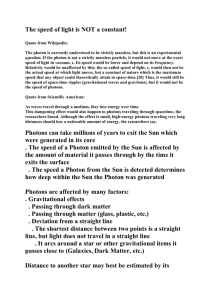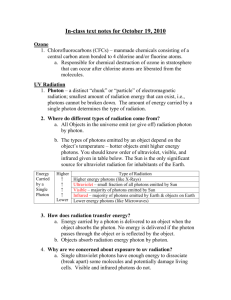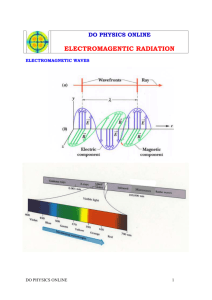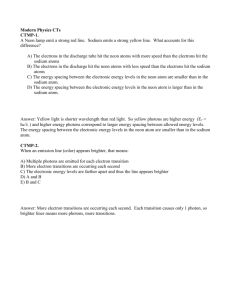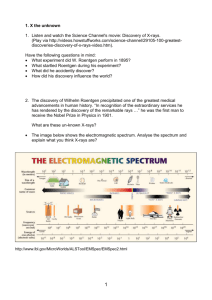The Interaction of Radiation and Matter: Quantum Theory (cont
advertisement
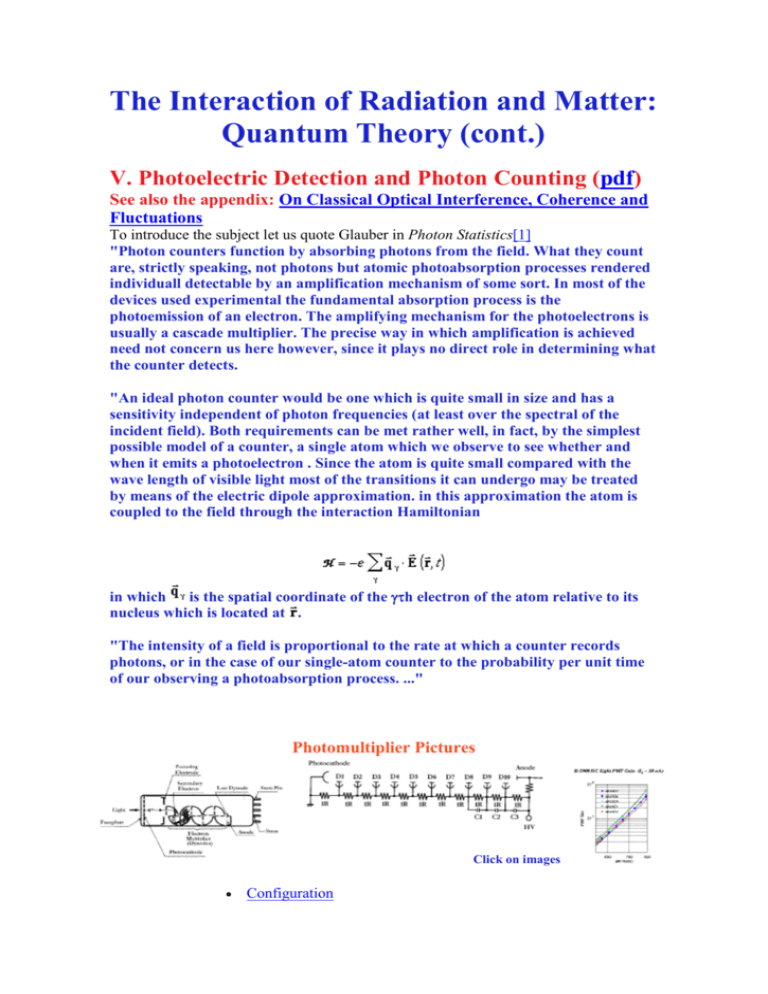
The Interaction of Radiation and Matter: Quantum Theory (cont.) V. Photoelectric Detection and Photon Counting (pdf) See also the appendix: On Classical Optical Interference, Coherence and Fluctuations To introduce the subject let us quote Glauber in Photon Statistics[1] "Photon counters function by absorbing photons from the field. What they count are, strictly speaking, not photons but atomic photoabsorption processes rendered individuall detectable by an amplification mechanism of some sort. In most of the devices used experimental the fundamental absorption process is the photoemission of an electron. The amplifying mechanism for the photoelectrons is usually a cascade multiplier. The precise way in which amplification is achieved need not concern us here however, since it plays no direct role in determining what the counter detects. "An ideal photon counter would be one which is quite small in size and has a sensitivity independent of photon frequencies (at least over the spectral of the incident field). Both requirements can be met rather well, in fact, by the simplest possible model of a counter, a single atom which we observe to see whether and when it emits a photoelectron . Since the atom is quite small compared with the wave length of visible light most of the transitions it can undergo may be treated by means of the electric dipole approximation. in this approximation the atom is coupled to the field through the interaction Hamiltonian in which is the spatial coordinate of the h electron of the atom relative to its nucleus which is located at . "The intensity of a field is proportional to the rate at which a counter records photons, or in the case of our single-atom counter to the probability per unit time of our observing a photoabsorption process. ..." Photomultiplier Pictures Click on images Configuration Circuit Gain With careful designed of high gain photomultipliers and associated circuitry, it is possible to register the atomic ionization caused by individual, isolated photons. Following Glauber then we will take the photoelectric interaction Hamiltonianas [ VI-1 ] where the 's are the relative spatial coordinates of the electrons bound to a nucleus located at . First-order perturbation theory informs us that the transition amplitudes associated with the process of photoelectric absorption are proportial to the matrix elements [ VI-2 ] where f and i signify, respectively, the final and initial states of the complete electronphoton system (See, for example, Equation [ II-16 ] in the lecture set entitled The Interaction of Radiation and Matter: Semiclassical Theory. Recall from Equation [ II-24a ] that [ VI-3 ] If the system starts in the lowest electronic energy state and energy is conserved in the transistions, only destruction operators contribute in first-order and, hence, the rate of photoemissive transitions from one particular initial electronic state (i.e.,the transistion probability of the detector atom absorbing a photon from the field at a position between times t and t+ dt ) is given by [ VI-4a ] Using Equation [ I-6 ] ] in the lecture set entitled The Interaction of Radiation and Matter: Semiclassical Theory and the now familiar identity , we see that [ VI-4b ] If we factorize the initial state as and where are, respectively, the initial electronic (atomic) and field (photon) states. [ VI-4c ] Summing over all initial states, we have the total probability of the detector atom absorbing a photon from the field at a position between times tand t+ dt. [ VI-5 ] where Thus, the total rate of photoemission from a given atom depends on the expectation value of the operator (or ) and this rate, in turn, translates -eventually -- into the value of the observed photocurrent in the photomultiplier. [ VI-6a ] However, so that we can write [ VI-6b ] We may then assert that this operator is (or is proportional to) the photon intensity operator which has an expectation value proportional to the observable light intensity.[2] and is particular value of the more general function [ VI-7 ] which is call the first-order correlation diadic (function). See classic discussion. Hanbury Brown - Twist Effect -- Correlation of Radiation from Incoherent Sources (See classical discussion) THE HANBURY BROWN - TWIST SPECTROMETER If we extend the arguments associated with the introduction of Equation [ VI-4a ] to find the joint count probability of a double photexcitation [ VI-8a ] Again using Equation [ I-6 ] ] in the lecture set entitled The Interaction of Radiation and Matter: Semiclassical Theory, we see that [ VI8b ] Summing over initial states [ VI8c ] where Quite generally, we can follow Glauber an define the nth-order correlation function (tensor) as [ VI7] Quantum Interpretations of Fundamental Interference Experiments Young Interference (See classical discussion) To simplify things, suppose that we parse the radiation modes involved in the Young's experiment as follows: Mode 1: Light distribution corresponding to the emergence of photons from pinhole 1. The field operators associated with this mode are . Mode 2: Light distribution corresponding to the emergence of photons from pinhole 2. The field operators associated with this mode are . Suppose that the two pinholes provide the only means of escape for the photons to the left. The number of photons which would be measured by a phototube directly behind ith pinhole is given by the expectation value of . If the pinholes are of equal size, then [ VI-10] (the factor insures that all operators satisfy the same commutation relationship). It is relative straight forward to show that [ VI-11] where j = 1 or 2. Suppose that the incident state (with n photons) can be written [ VI-12 ] so that [ VI-13 ] Thus for a n-photon, single mode incident beam, the intensity at an observation point Q is given by [ VI-14a ] or [ VI-14b ] Thus, the same intensity distribution as observed for a large number of photons n can be built up by doing n experiments with one photon! The interference is a one photon effect and does not depend in any way on the interaction of photons with each other. Hanbury Brown - Twiss Interference (See classical discussion) Following an argument identical to that used above, we see that the correlation between photomultiplier currents is proportional to [ VI-15 ] Thus, the degree of second-order coherence is [ VI-16 ] n = 1 2 0 1 0 3 4 ÖÖ ÖÖ 2 3 [1] From Fundamental Problems in Statistical Mechanics II (edited by E. G. D. Cohen), North-Holland Publishing (1968), pp. 140-187. [2] This interpretation is consistent with Equation [ II-27b ] which gives the Poynting vector as Therefore, [3] Much of this draws heavily on excellent discussions in Chapter 6 of Rodney Loudonís The Quantum Theory of Light (2nd edition), Oxford University Press. Back to top This page was prepared and is maintained by R. Victor Jones, jones@deas.harvard.edu Last updated April 24, 2000






